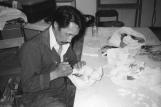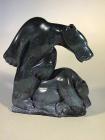2
Johnny Aculiak [1951 - 2008]"I want people who buy carvings to know what it takes to produce the things they are buying. I want them to know that the price they pay is small for the amount of energy spent in producing it." (1997)
"I try to encourage younger people to carve. I emphasize the fact that young people should follow the traditions of their forefathers. It seems to me that our culture will die off one day if we do not keep carving. The carvings we make show the Inuit way of life. I notice that we are losing our language. The younger generation mainly speaks English and if that keeps up, our language will die. This is a very big concern for me. In spite of the hard work required to quarry stone in the winter, when the rock is covered with snow, I do it in the hope that our culture will be passed on through our carvings. If the carvers were to all die, we would not have anyone to carry on the tradition that we have continued through our carvings."
His story
Johnny Aculiak was born in 1951 in Inukjuak. After his father died, he and his older brother worked to support the family. This was, perhaps, one of the reasons he took up carving in 1968. He recollected during an interview with Henry Kudluk in 1997 that he started carving because he envied the carving skills of his friends. "They could do what I couldn't. That gave me a lot of anxiety, not being able to carve like them. I really wanted to learn. When I was young, I would work away on a carving until someone came along. Then I would quickly pretend I was not carving. I used to be ashamed, thinking that my carvings were not good enough for people to look at. All the time I was carving, I would keep an eye out to see if people were coming my way. Eventually, I lost my shyness about carving" (p. 24).
Self-taught, Aculiak worked with a variety of materials, although he preferred soapstone. Known for his sculpture, he has also made drawings and jewellery. In 1987, he and his wife Lily went to Europe and Russia, accompanying Things Made by the Inuit, an exhibition organized by La Fédération des Coopératives du Nouveau-Québec, which included some of his work.
His art
Johnny Aculiak preferred to work with hand rather than power tools, and felt that there should be a distinction between the two: "I think that carvings made with hand tools should be separated from the carvings made with power tools. I think that carvings made by power tools are overpriced," he told the Inuit Art Foundation in 1997. However, he admitted that hand tools limited his creativity. "It is a challenge for me to make what I want without the use of power tools." Occasionally, he added elements of ivory or caribou antler to his soapstone carvings. Aculiak quarried his own stone, a task that he acknowledged was challenging. "It is not an easy job quarrying stone from the land. Every year we have to find a shabby boat to take us to the stone. The boat might have no proper pump to drain water. We drain water from the boat by hand because it leaks, and when we get to the quarry site, we have to take the rock out of the ground without proper quarrying tools." As for his favourite subject matter, he said: "I like carving Inuit people. I used to get requests from teachers who wanted me to make something specific for them. I would always try even if I had never made it before. Mostly they wanted birds. I was already being told that I was a good carver, even when I had no idea of how to price a carving."
References
Lily Aculiak was interviewed by Inuit Art Foundation staff in Inukjuak in 2009.
Kudluk, Henry
1997 "Johnny Aculiak: 'It seems to me that our culture will die off one day if we do not keep carving'," Inuit Art Quarterly (IAQ), vol. 12, no. 4 (winter):24-28
4
"Caribou Hunt" by Johnny Aculiak2006
Inukjuak, Quebec, Canada
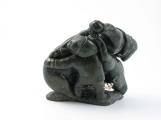 Credits:
Credits:La Fédération Coopératives du Nouveau-Québec
Photo: Bernard Murdoch
5
Carving by Johnny Aculiak2007
Inukjuak, Quebec, Canada
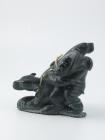 Credits:
Credits:La Fédération Coopératives du Nouveau-Québec
Photo: Bernard Murdoch
6
Carving by Johnny Aculiak2007
Inukjuak, Quebec, Canada
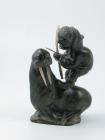 Credits:
Credits:La Fédération Coopératives du Nouveau-Québec
Photo: Bernard Murdoch
7
"Hunter with An Avataq Float" by Johnny Aculiak2008
Inukjuak, Quebec, Canada
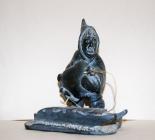 Credits:
Credits:Photo: Devora Cascante
8
"Hunter with Harpoon" by Johnny Akuliak1980 - 2000
Inukjuak, Quebec, Canada
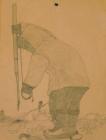 Credits:
Credits:Photo: Inuit Art Foundation
Courtesy of Lily Aculiak
9
Drawing by Johnny Akuliak1980 - 2000
Inukjuak, Quebec, Canada
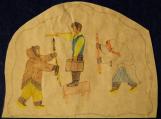 Credits:
Credits:Photo: Inuit Art Foundation
Courtesy of Lily Akuliak
10
"Pop Can Man" by Johnny Akuliakn.d.
Inukjuak, Quebec, Canada
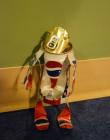 Credits:
Credits:Photo: Inuit Art Foundation
Courtesy of Lily Akuliak
